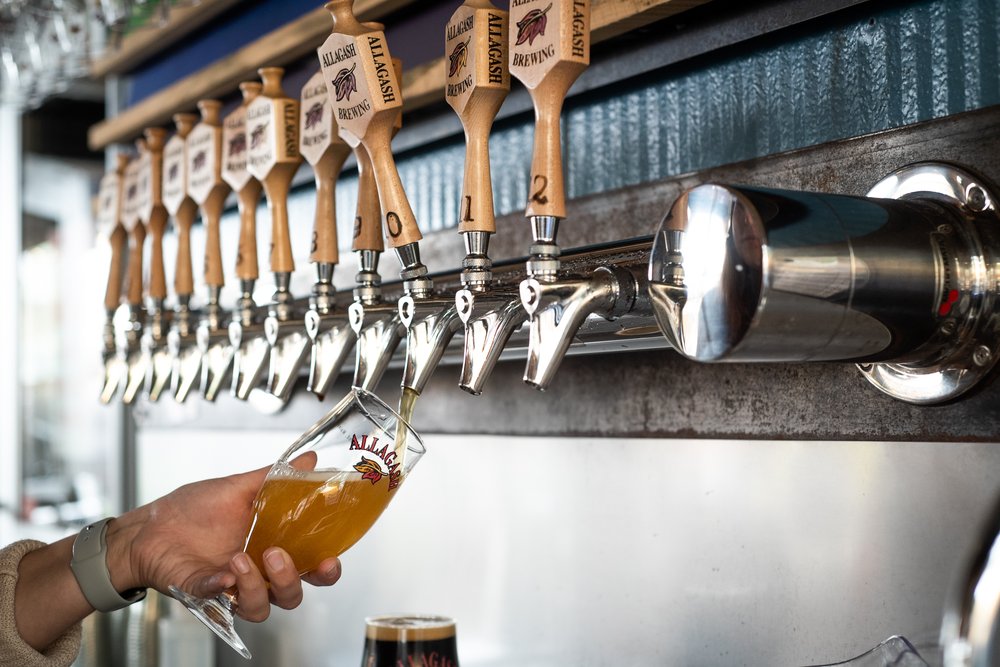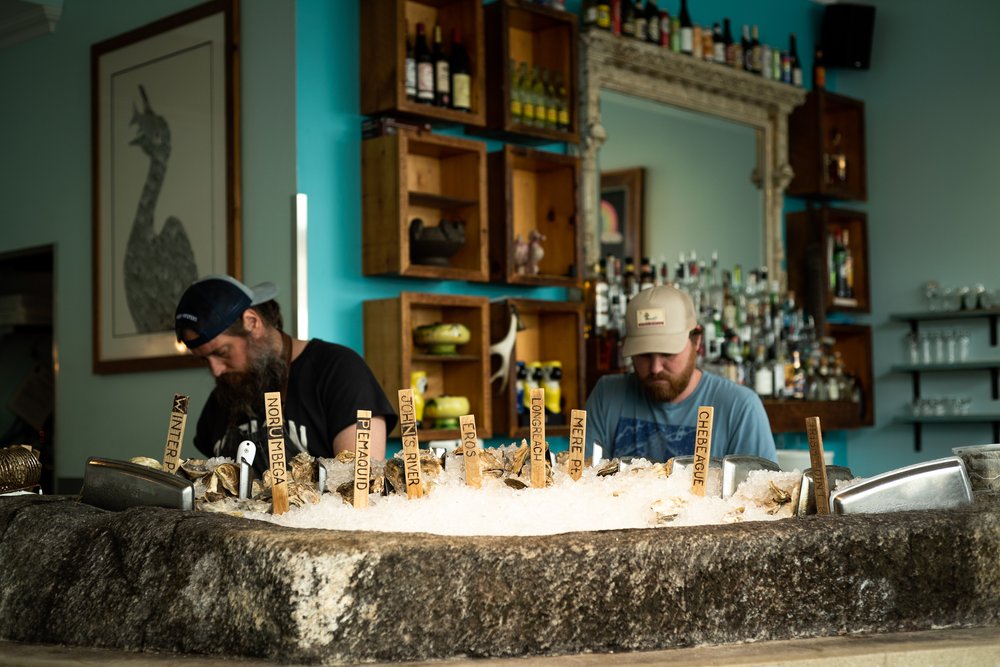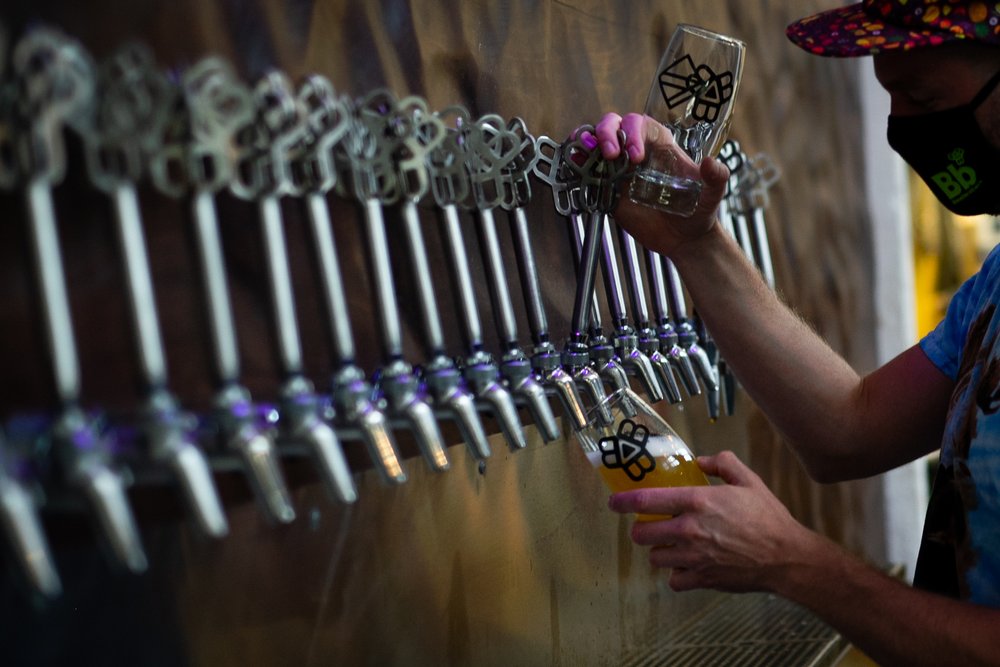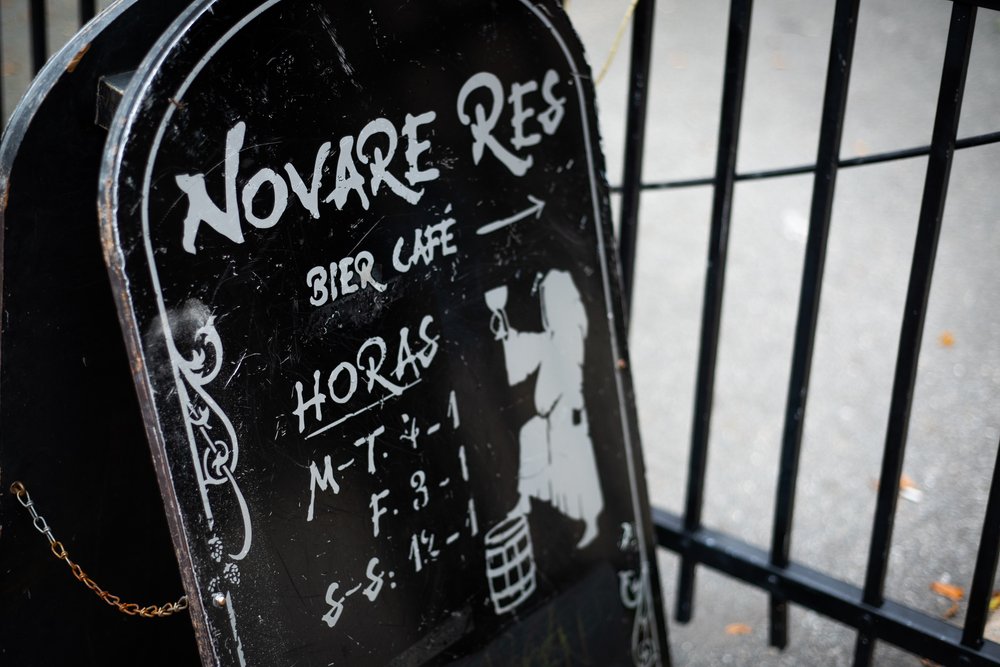
It is a warmer-than-usual Friday evening in the coastal city of Portland, Maine, and there’s a buzz in the air. Downtown is crowded with people peering into restaurants, inquiring about wait times. Trey Anastasio of the band Phish and soul singer Leon Bridges are both in town. The season for tourism and concerts and long lines is nearly over, but tonight people are holding onto summer.

There are the limitations of its size (just under 67,000 residents) and its demographics (84.6% white), but Portland feels in the midst of change, home to an attention-getting food and drinks scene and a growing dynamism. There’s the seafood coming right out of the water, visible from almost anywhere in Portland, but the city isn’t just lighthouses and lobster anymore. I’ve come for Tex-Mex, noodles, Belgian-style frites, and whatever anyone points me in the direction of.

If I have a problem, it’s time: There’s not enough of it, and I can’t eat and drink everywhere I want to. On the drive up to the city, soundtracked by Taylor Swift’s “Folklore,” I kept doing mental Tetris, unsure of how I would fit everything in. And so I stand on the corner of a crowded street, the smell of Thai-style fried chicken in the air, my feet angled in the direction of my last stop—one of the best beer bars in the world. In an alternate reality, this is how I would spend every Friday night. “I could live here,” I think, for perhaps the thousandth time.
‘I HAVE THIS DREAM YOU’RE DOING COOL SHIT’
I’m aware that the clock is ticking the moment I pull into the parking lot at Allagash Brewing Company. My itinerary is perhaps too packed, as photographer Jennifer Heidrich will tell me many times. But a journey of 1,000 drinks begins with the first Allagash White—or something like that.

Allagash is typically where I begin my trips to Portland. When the brewery hit the scene in 1995 with a Belgian Wit (mononymously known as White), Portland wasn’t the beer destination it is now. But in the last quarter century, Allagash has become the standard-bearer for quality and craftsmanship in a beer-rich city. Today, very few people in the craft beer community—from casual drinkers to jaded industry folk—have negative things to say about it. (Instead, it’s a well-known #BeerTwitter truism that posting pictures of an Allagash beer will earn you instant likes from fellow beer geeks.) And I don’t know if I’ve been to any other brewery where people are more proud or more happy to say they work there.
The brewery also plays an active role in its community through charitable endeavors. As an example, in 2020, the company’s founder Rob Tod intended to donate $10,000 to organizations supporting racial justice and equity, like the Indigo Arts Alliance and Maine Inside Out. When a customer called to voice their displeasure with this, Tod raised the company’s contribution to $18,000.


As usual, the outdoor space at Allagash is already packed when I arrive. I’m greeted with a private table and a half-pour of Hop Pilot #630. The sun is out and there’s a well-behaved dog sitting behind me. I want to tell my hosts how great it feels to be here again after such a long time, but they deflect the praise. “Everyone was just able to pivot so well,” says Lindsay Bohanske, otherwise known as “L-Boh,” who is the tour and tasting specialist at Allagash. “People got moved from all different roles to help where it was needed during the last year.”
On May 1, 2021, Allagash finally reopened to visitors for the first time since the pandemic began. In the interim, the brewery relied heavily on packaged sales and to-go orders fulfilled right out the front door. Motivated by urgency, “Tasks that were scheduled for six months were suddenly being managed in three,” says marketing specialist Brett Willis. While 12-packs of the flagship White had already been released, 12-packs of other beers like River Trip (a Belgian-style Session Ale) and Nowaday (a Belgian-style Blonde) hit shelves way ahead of schedule.



Reopening hasn’t meant a return to how things were done before, however. Even today, as summer fades to fall, visitors are only permitted outside. And despite the fact that White is the bedrock of the brewery, commonplace in the 20 markets in which it’s sold, the company is still very much interested in presenting something new and unique to customers, in continually updating its offerings. Allagash released 25 beers, including Fine Acre, a Golden Ale that is 100% organic, to the public last year, after releasing 22 new beers in 2020, and nine in 2019. Doing so is a way of fighting staleness, and staying relevant in a saturated market.
“I love beers with a story,” says Bohanske. “Ghoulschip is a beer with a great story.”
On Halloween every year, Ghoulschip, a beer brewed with local pumpkins, molasses, and pumpkin seeds, is sent to rest in Allagash’s coolship overnight. It’s then transferred to a stainless steel tank and inoculated with house yeast before being transferred for a rest of up to three years in oak (the microflora “sours the beer,” according to Willis, and the house yeast aids in fermentation). The beer is ultimately a blend of one-, two-, and three-year-old beer.
“My wife literally just sent me a message with a picture of the Ghoulschip Instagram post,” I tell Bohanske and Willis. “No comment. Just the picture. I guess that means she wants one.”

To go with its ever-changing selection, there have always been food trucks outside Allagash, but the permanent fixture is Bite Into Maine. It offers a “flight” of lobster rolls—and even cooks its brats in Nowaday.
“We wanted to provide the authentic Maine experience,” says Bohanske, which in this case means Allagash White and lobster rolls. It’s hard to argue with that vision—though it might not be the whole story.
‘TIME, WONDROUS TIME’
After a ride from the brewery to the Old Port district on the other end of town, the dichotomy is apparent. On one side of the road stand restaurants of regional—if not national—acclaim. Tourists flock to bakeries and souvenir shops for aprons touting the “Maine Thing is Lobster,” and bachelorette parties “woo!” their way through the bars. On the other side of the street, fenced off like an eyesore, is the shipyard, its occupants hardened dock workers and fishermen. Without one side, there wouldn’t be the other. Before these fish get dressed up on our plates, they have to come from somewhere. It is a master class in cognitive dissonance.
English settlers described the abundance of lobster on New England shores as early as the 1600s. Maine established the first commercial lobster pound in 1875. Previously considered a food for enslaved people, apprentices, and prisoners (some workers went so far as to negotiate a “no more than two days of shellfish” clause into contracts), lobster grew from something reviled into a symbol of wealth and fine dining.
I never saw seafood the way it is available here. The bounty and freshness of our seafood is incredible. Obviously lobster is a huge part of that.
New food technology and railway transportation helped provoke this shift. Lobster was easily canned and shipped, and quickly became a popular food item far from the coast. Tourists used the railways to travel to coastal cities and devour fresh lobster, inspiring restaurants to develop new cooking techniques and recipes, which, in turn, drove prices up due to demand. It has never ceased in its ascent.
“I never saw seafood the way it is available here,” says Arlin Smith, general manager of Eventide Oyster Company. “The bounty and freshness of our seafood is incredible. Obviously lobster is a huge part of that.”

Eventide, located less than a quarter mile from the Portland Harbor, is one of the city’s more acclaimed—and touristy, it warrants mention—restaurants. To illustrate this point, at 1:30 on a Friday afternoon at the end of the summer, there’s a two-hour wait. Even including it in this piece may provoke dissenting grumbles from hardcore Portlanders. But just as many people will likely react with pantomimed drooling.
The dining space is entirely outdoors, picnic tables arranged under a tent. The brown butter lobster roll, served with warm butter and chives on a steamed bun, is a bucket-list contender. But Eventide has more on offer than just lobster. There are fresh oysters at the raw bar, ceviche, and chowder. Suddenly a bounty arrives at my table in the form of smoked lobster and corn fritters; bluefin toro with chow chow, miso mayo, and koji; and tuna crudo topped with ginger, scallions, and radish.



“Holy shit,” I say involuntarily after inhaling a mouthful of tuna. If this were poker, I’d have shown my hand by the look on my face alone. This surprise is indicative of the Portland dining experience: Come for one thing, stay for another.
“We originally just wanted to be this tiny little restaurant with an oyster bar,” said Smith. “We thought we were just gonna hum along, and have some busy days. The response smacked us in the face like, ‘Wake the fuck up. What you’re doing, no one else is doing!’ It’s normal seaside shack fare presented in an interesting and fun way.”

As with most bars and restaurants in the city, it’s possible to get great beer at Eventide. Portland is like this. Good beer is everywhere, from high-end seafood places to concert venues and dives.
“Those relationships with the breweries and restaurants are so unique,” Smith says. “They’re doing things outside the box and doing them really well. That, coupled with restaurants doing similarly unique things, and they just jive and feel authentic and genuine. We don’t take this for granted.”
‘I HATE THE CROWDS, YOU KNOW THAT’
I like Portland’s sleight-of-hand. It looks like a single-dish city until you venture beyond the lobster and discover how much more is going on. As a beer destination, it’s similar. Come to the city with the expectations of a world-class experience at Allagash, and stay for any of the other great breweries, from Austin Street Brewery to Oxbow Brewing Company, from Bunker Brewing Company to newcomer Belleflower Brewing Company.

It’s impossible to talk about Portland’s beer scene without also discussing Bissell Brothers Brewing Company, on Thompson Point. The brewery was at the forefront of the New England IPA scene when it started with a solitary beer, The Substance, back in 2014. It was originally housed on Industrial Way (the same street as Allagash), but has since moved into this mammoth, 300-person-capacity facility. The place is colorful and lively. Patrons walk around freely holding murky samples of hop-forward beers. As usual, Thompson Point is packed. This is where Anastasio is playing tonight.
To be quite honest, I’m not much interested in fighting the crowds for Phish or the hoppy beers at Bissell Brothers. That said, I do recognize their respective popularity and appeal: They’re both predictable and consistent in the best possible senses of those words. But I’m much more interested in the fact that the company, owned by Peter Bissell and his brother Noah, opened up a secondary facility in Milo, Maine—a town of just over 2,000 people—which is two-and-a-half hours north of where we’re sitting now.



“We knew that if we were going to do these beers, we needed to do them right,” says Peter Bissell over a pour of a foeder-fermented Grisette. “And to do them right we needed the space and the time.”
Bissell recognizes there’s a luxury in this statement. The New England IPAs alone could keep the lights on, as well as pay the 60 employees, none of whom were laid off during the pandemic. But the brewery hasn’t used that as an excuse to stop experimenting.

“I wanted the people here to know I stood for two things,” he says. “I didn’t want any layoffs. And when it came to switching into Lagers and Saisons, it was going to be tough to double down on them, but we had to approach it the correct way. There’s nothing to hide behind if you make these beers poorly. You can’t get away with it in this city.”
Bissell is also taking a similar approach to the newly opened on-site kitchen, which offers everything from a Nashville hot chicken sandwich to mushroom tacos.
I wanted the people here to know I stood for two things. I didn’t want any layoffs. And when it came to switching into Lagers and Saisons, it was going to be tough to double down on them, but we had to approach it the correct way. There’s nothing to hide behind if you make these beers poorly. You can’t get away with it in this city.
“We had to approach the food the way we approached the beer,” he says. “Otherwise it wouldn’t work.”
By this, Bissell means crafting a menu with a similar intent—forward-thinking and crowd-pleasing dishes, with an eye toward quality. The brewery hired a chef and is aiming for a kitchen space that can compete with the local restaurants. Otherwise, people will simply spend their dining money elsewhere.

I’m fascinated by the pace of Bissell Brothers, which seems antithetical to a coastal vacation spot. It matches the energy of its co-owner, and the freneticism of the place—loud music, big crowds—reminds me of the beers. It’s a sensory overload just like a big, bold DDH IPA, and it’s an odd contrast to the slow beers—the Festbier, the Grisette, a Rice Lager conceptualized and brewed by the women at Bissell Brothers—that I’m more interested in drinking. To me, it feels like these are the beers that should be hyped here.
‘YOU ARE NOT LIKE THE REGULARS’
It’s tempting, when visiting a place that you love, to revert to the comfort of familiarity. We return to our favorite restaurants for a reason. We’re placated by the idea that we know exactly what we are getting, and that we will be satisfied when the check comes. And so it was tempting to visit places in Portland that I’d already been to. The beauty, though, of traveling is in the discovery of new spots. The most memorable things we do tend to be unplanned. In other words, I’d never even heard of Crispy Gài.
“Crispy Gài is my favorite spot in the city right now,” Oxbow’s Tim Adams told me. “Cross off a place you were planning on going and go there.”

Crispy Gài is the brainchild of Jordan Rubin, who runs the popular Mr. Tuna food truck (which is now also a 16-seat sushi bar in the Portland Public Market), and Cyle Reynolds, who has worked in Michelin-starred restaurants in Bangkok, Chicago, and New York City. The restaurant’s signature dish is hat yai fried chicken: drumsticks and thighs rested in a Thai pepper brine and served extra crispy with fried shallots. I ordered mine with a sweet chili sauce called nam jim gai and a side of sticky rice.
“Inside the restaurant, it’s a vibe,” says Reynolds. “There’s loud music, it’s colorful. It’s fast-paced but professional. There is a level of service I’m proud of.”
It’s in its prime for what COVID would allow. I feel like if we look at Portland in 10 years, it will be totally different. There’s still room to grow from a point of adding more diversity.
The people inside Crispy Gài are a mix of older, more serious eaters and young professionals. There are shirts and ties. There are tattoos. The beer list is Portland-centric (an Oxbow beer called Surfcasting, a 4% Grisette with sea salt and lime, is the pick). The cocktail list is extensive and varied, and features drinks made with mezcal, rum, and cachaça.
“Every service, I feel like I recognize 60% of the people,” says Reynolds. “A lot of industry people come to eat. To me, that’s a really good sign.”
To accompany my chicken and rice, Reynolds brings out a dish of som tum—green papaya salad with heirloom cherry tomatoes, peanuts, long beans, toasted dried shrimp, and tamarind palm sugar dressing. It’s spectacular in the way it combines sweet and spicy, and builds layers of complex textures and flavors.


By 7:45 I’m the elephant in the room, with four plates of food in front of me and no other dining companions. People waiting for their tables linger in the entrance. I need to leave.
With several meals down, it’s hard not to feel like Portland’s restaurant scene is in its prime—despite everything that’s happened over the last two years. It’s the availability of fresh, seasonal ingredients; it’s the low overhead that makes it easier for new businesses to take a gamble; it’s the young, eager chefs talented enough to step in and start right out of the gate.

“There’s so much talent still coming in,” says Eventide’s Smith. “It got pretty close to being in its prime pre-COVID, but now we’re starting the next chapter. There are so many awesome things happening.”
Rubin agrees.
“It’s in its prime for what COVID would allow,” he says. “I feel like if we look at Portland in 10 years, it will be totally different. There’s still room to grow from a point of adding more diversity.”
In all honesty, I’m not sure how restaurant critics do it. I’ve eaten two meals today and I’m considering skipping the post-dinner plan to go to sleep. But, as they say, big-time players show up for the big games. It doesn’t hurt when that final stop is widely considered one of the best beer bars in the entire world—and it’s 400 yards away from where I stand outside Crispy Gài, full of fried chicken and sticky rice.
‘THEIR PARTIES WERE TASTEFUL, IF A LITTLE LOUD’
There won’t be many lists of the best beer bars in America that don’t mention Novare Res Bier Café. Opened in 2008, the bar quickly distinguished itself with its global perspective, with beers from Belgium, Germany, and England, as well as world-class breweries within the United States, all served on draft. Often, Novare Res is the only other place outside of these breweries that pours their beers. In the bar’s younger years, the sole Maine brewery that appeared on its menu was Allagash. Now, it’s not uncommon to have multiple Maine beers on tap or sold in bottles or cans.

Prior to my final stop at Novare Res, I knew that I’d only be staying for a couple drinks. It’s the kind of place where you’re probably going to have your two best beers all day. It’s a place where you may find something on tap you never thought you’d try. It’s also a place where I considered it highly likely I would see someone I knew. The idea was welcome: Journalists walk this weird line between solitude and gregariousness. We research, brainstorm, transcribe, and obsess over word choice and structure. In between, we’re engaged with people—and by the end of the day, that’s what I needed more of.
It’s Oktoberfest at Novare Res when I visit, so there are staff members in lederhosen and someone carrying 14 glass steins across the room as co-workers cheer him on. I order Eiszäpfle, a Märzen from the German brewery Rothaus. True to my expectations, I soon notice a brewer I know, and chat for a few minutes before seeing another familiar face across the barroom floor.
Earlier this year, Notch Brewing’s then-production manager, Brienne Allan, set the beer world ablaze with a post on her Instagram Stories, which ignited a firestorm of long-overdue stories of sexism and mistreatment within the beer industry. She’s since left Notch and now lives in Portland. I’ve known Allan for a couple years through my coverage of the industry, and I stop and say hello.

We speak candidly about the industry, her decision to leave Notch and what is or isn’t next (I’m sworn to secrecy), our shared opinion on the quality of canned beer (not sworn to secrecy), about the role men should be playing—but are not—in Brave Noise and other such initiatives, and about what journalists should be doing in the same space. These are the types of conversations that take place over a couple pints of beer, and which happen off-the-record, even when not directly stated. And, thus, I cannot—and will not attempt to—quote Allan here.
Eventually, my night starts winding down, and Allan has friends to return to. I had stashed a couple cans of Allagash’s From Maine, With Love #07 (a Pale Ale with Saison yeast) in my hotel fridge, to be enjoyed within the comfort of my room, perhaps while watching a mildly entertaining college football game. But first, as is procedure, I need one more. After all, you can’t come to Novare Res and have just one drink. (Can a bird fly on one wing?)
Like most people who visit Novare Res, I spent a considerable amount of time in the days preceding my visit monitoring what was on tap. You do the hypothetical, “Well, if I were there today, I would definitely try…” and you isolate a handful of beers you hope still have legs on your visit. In fact, there are multiple beers on tap tonight that I have dog-eared.

But, in the spirit of this piece, I decide it would be unfair to go with a beer of my own choosing.
“Pick a beer for me,” I ask Allan. She agrees.
“Brienne is going to choose my beer,” I tell the bartender.
“Great choice,” they say. “You picked a good person to do that.”
“At maybe the best place to do that,” I reply.
Allan leans over the bar slightly, tap list under her hand, thinks for a moment, and places my order. I can’t hear her over the music. With that, the bartender turns to the tap and begins pouring.

